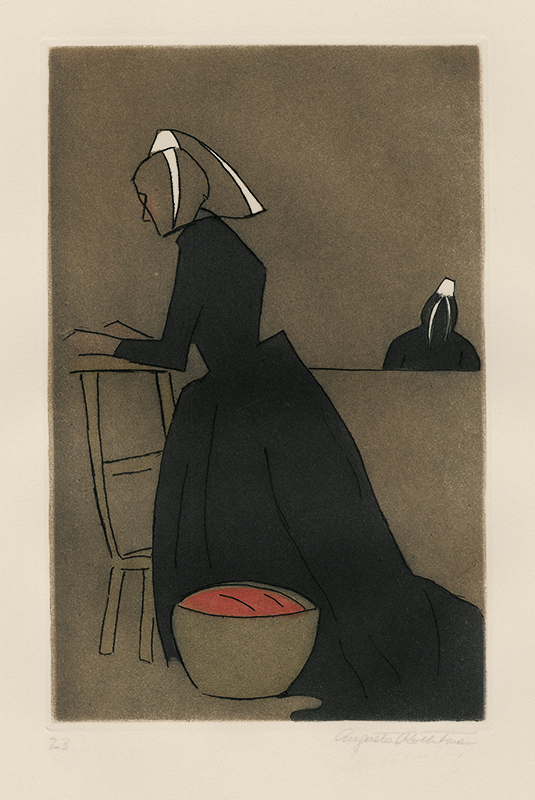
19th, 20th & 21st Century Fine Prints
707-546-7352 · fax 707-546-7924 · web: www.annexgalleries.com · email: artannex@aol.com
Woman Praying - Brittany by Augusta Payne Rathbone

Woman Praying - Brittany
Augusta Payne Rathbone
Woman Praying - Brittany
Augusta Payne Rathbone
1897 - 1990 (biography)Augusta Rathbone depicts a woman at prayer in Brittany, northern France, dressed in traditional clothing. The artist keeps her composition simple and serene, a figure in profile, a basket, a chair and a figure in the background. The quiet brown background is interrupted with a red/orange in the basket and small areas of white in the headdresses. An irregular black shape, the subject's dress, predominates the composition, creating a tension.
Augusta Payne Briggs Rathbone, painter and printmaker, was born in Berkeley, California on 30 November 1897. In 1900, her parents, Henry and Julia Briggs Rathbone, were living in the San Francisco home of her grandparents, Obil and Mary Briggs, and that same year her mother passed away. After the 1906 earthquake and conflagration, Rathbone was sent to live in Berkeley with her aunt, Edith Moses. Rathbone eventually returned to San Francisco where she attended Miss Hamlin’s School for Girls and Young Ladies. She received her BA degree from the University of California Berkeley in 1920 and the following year she sailed to Paris where she continued her studies at the Académie de la Grande Chaumière. She also studied with Lucien Simon and for several years with the Spanish artist Claudio Castelucho y Diana.
Rathbone returned to France for extended periods over the next eighteen years and her studio was located at the University Women’s Club now known as Reid Hall. Painting and sketching were her main interests until her introduction to printmaking in 1927 by the artist Nora Hamilton of Chicago. Rathbone began to concentrate on printmaking and took her plates to Monsieur Alfred Porcabeuf in Paris for printing. Her earliest intaglios featured the Sierra Nevada and urban scenes of New York and San Francisco. In the late 1930s, Rathbone created etching and aquatints of the villages in Brittany and the French Riviera. After World War II, she returned to Paris but in the face of prohibitive printing costs she purchased a small press and taught herself how to print her plates.
While in Paris in 1927, Augusta Rathbone became further acquainted with printmaking and thereafter worked primarily in color aquatint combined with line etching. Rathbone, who had studied briefly with Bonnard, uses a freely drawn black etched line to capture rough shapes which are then filled with color, using aquatint. She worked with a professional printer Alfred Porcabeuf in Paris, who would prove her prepared plates. In the 1930s she traveled the French Riviera and her color palette adapted to the colorful villages throughout the region.


